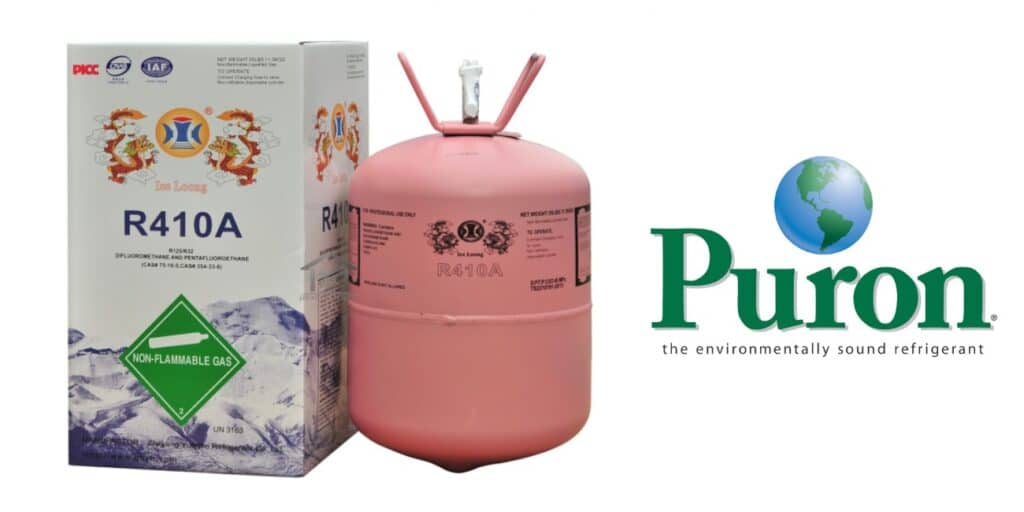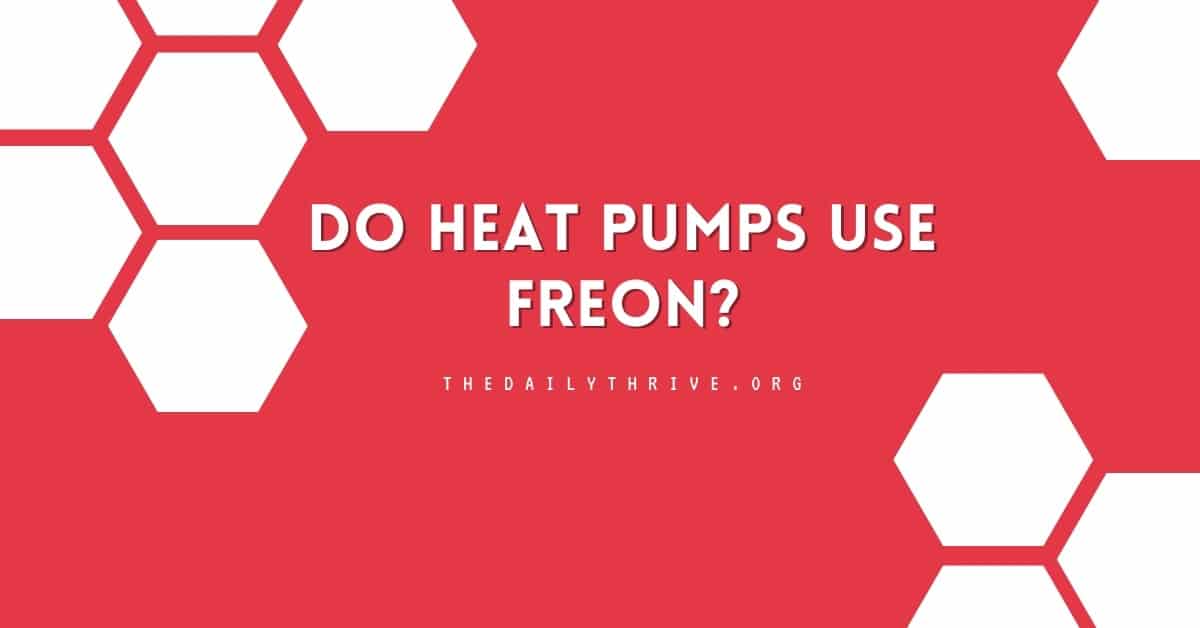Heat pumps are an all-in-one type of HVAC unit, highly efficient in heating your house in the winter and cooling it in the summer. Heat pumps stand out for their significantly lower energy consumption compared to traditional heating systems. A frequently asked question about these systems is: do heat pumps use Freon? The answer varies, primarily depending on the model and, more specifically, the age of the unit.
Like air conditioners, all heat pumps utilize refrigerant in their operation. Older models may still operate on Freon (also known as R-22). However, Freon has been phased out for over a decade due to environmental concerns. Beginning in 2010, regulations required all new air conditioners and heat pumps to use less harmful refrigerants, with R-410A, or Puron, becoming the most common substitute.
Consequently, any heat pump unit installed after January 1, 2010, does not use Freon, though many older units still do.
What Is Freon?
Freon, widely recognized by its chemical designation R-22 or HCFC-22 (Hydrochlorofluorocarbon-22), is a chlorofluorocarbon (CFC) that has been traditionally used as a refrigerant in various cooling systems, including heat pumps, air conditioners, and refrigerators. It absorbs heat from one area and releases it in another, playing a critical role in the heat exchange process that defines these cooling systems.
The popularity of Freon in older heat pump units and other cooling appliances can be attributed to its effectiveness in the heat exchange process and its physical properties, which made it suitable for a wide range of operating conditions. However, the use of Freon has been heavily curtailed and regulated due to its environmental impact.
Freon is known to contribute significantly to ozone depletion. When released into the atmosphere, Freon’s chlorine and fluorine atoms break down ozone molecules. This depletion of the ozone layer leads to increased ultraviolet radiation reaching the Earth’s surface, which can cause health hazards like skin cancer, cataracts, and environmental issues.
The Montreal Protocol, an international treaty designed to protect the ozone layer, mandated the phase-out of ozone-depleting substances, including Freon. As a result, from January 1, 2010, the production and import of Freon in new equipment were banned in many countries, leading to a shift towards more environmentally friendly refrigerants like Puron (R-410A), which do not contribute to ozone layer depletion.

Types of Freon Used by Heat Pumps
There have been three main types of Freon used in heat pumps, each with its history and environmental impact.
R12
- Type: Chlorofluorocarbon (CFC).
- History: R12 was widely used until it was discovered to contribute significantly to the greenhouse gas effect and climate change.
- Phase-out: It was phased out in 1994 due to its harmful environmental impact.
R22
- Type: Hydrochlorofluorocarbon (HCFC).
- Usage: After R12 was discontinued, R22 became the prevalent refrigerant in air conditioners and heat pumps.
- Environmental Impact: Like R12, R22 was found to harm the environment.
- Current Status: Although R22 was phased out in 2020, it’s still legal to use heat pumps or AC units that contain R22. However, sourcing R22 for maintenance or refills has become increasingly difficult due to its discontinuation in the U.S.
R410A (Puron)
- Type: Hydrofluorocarbon (HFC).
- Characteristics: R410A, or Puron, is a newer refrigerant blend designed to be less environmentally harmful.
- Advantages: Heat pumps using Puron are generally more efficient and reliable than those using R22.
Despite the phase-out, Freon is still available in limited quantities for servicing older heat pump units and air conditioners that were designed to use it. However, the dwindling supply and increasing regulations around its use have prompted many to transition to systems compatible with newer, eco-friendly refrigerants.
This change aligns with environmental regulations and ensures the long-term viability and efficiency of cooling systems.
How Does Refrigerant Work in a Heat Pump?
The function of refrigerants in a heat pump, be it Freon, R-410A, or any other variant, centers on the principle of heat transfer. The core objective of the refrigerant is to absorb heat from one location and transport it to another, either inside or outside a building.
Refrigerant in Cooling Process
In the cooling mode, heat pumps operate similarly to air conditioners. The process begins with the compressed refrigerant, elevating its temperature and transforming it from a gas to a liquid. Now, under high pressure and extremely cold, this liquid refrigerant travels through copper lines to the evaporator coil inside the building.
Indoor air, warmed by the building’s interior, is pulled into the ductwork by the HVAC blower through return air vents. This warm air passes over the evaporator coil, where the colder refrigerant absorbs heat. As the refrigerant removes heat, the air cools down and is redistributed throughout the building via supply vents.
The absorption of heat by the refrigerant raises its temperature, turning it back into a gas under higher pressure. This continuous cycle involves cold refrigerant flowing to the evaporator coil and the now-warm gaseous refrigerant returning to the heat pump. The refrigerant then enters the condenser coil, releasing most of its heat to the outside air. Afterward, the refrigerant cycles back to the compressor, and this loop repeats until the desired indoor temperature is achieved.
Refrigerant in Heating Process
The unique feature of a heat pump that distinguishes it from an air conditioner is its ability to reverse this process for heating purposes. In the heating mode, the refrigerant captures heat energy from the outside air and transfers it indoors.
Initially, the refrigerant is compressed, making it colder than the outdoor air. This temperature difference allows the refrigerant to absorb heat from the outdoor air through the heat pump’s coil. After absorbing enough heat, the refrigerant moves through an expansion valve, where a sudden drop in pressure turns it back into a gas, further elevating its temperature.
This hot refrigerant is then circulated to the indoor coil in the air handler. The HVAC blower draws in colder indoor air, forcing it over the hot coil. The heat from the refrigerant transfers to the air, warming it. This heated air is distributed throughout the home, raising the indoor temperature.
Regardless of their type, refrigerants in heat pumps play a vital role in the efficient transfer of heat, either removing heat from the indoors during cooling or bringing heat inside during the heating season. This versatility and efficiency make heat pumps a highly effective solution for year-round temperature control.
What to Do If You Find a Refrigerant Leak in Your Heat Pump
A common misconception about heat pumps is the need for regular refrigerant top-offs, similar to car refueling. However, this is not the case. Heat pumps are designed as closed systems, where the refrigerant is not consumed but reused continuously.
The amount of refrigerant is carefully measured and installed in the system to last its lifetime. It circulates within the sealed system, meaning it should neither diminish nor require replenishment under normal circumstances.
The only time a refrigerant top-off might be necessary is if there is a system leak, which requires professional attention.
If your heat pump leaks refrigerant, it’s a serious issue that needs immediate attention. Here’s a deeper look at what to do and the signs to watch for:
- Contact HVAC Service: If you notice these signs, contact a local HVAC service for inspection.
- Leak Detection and Repair: The technician will check for leaks and repair them. It’s crucial to fix leaks to replenish the lost refrigerant and ensure the system operates efficiently and doesn’t cause further damage.
How to Tell If Your Heat Pump Is Low on Refrigerant?
Whether your heat pump uses Freon, Puron, or another refrigerant, certain symptoms can signal a low refrigerant level:
- Uneven Home Temperatures: If some rooms are cooler or warmer than others, it could indicate insufficient refrigerant.
- Frozen Evaporator Coil: A telltale sign of low refrigerant is ice formation on the evaporator coil inside the unit.
- Ice on the Heat Pump: Ice buildup on the heat pump unit indicates a refrigerant problem.
- Higher Energy Bills: A sudden increase in energy bills can result from the heat pump working harder to compensate for the low refrigerant.
- Hissing or Bubbling Noises: Such sounds from the heat pump can indicate a refrigerant leak.
A refrigerant leak in a heat pump is a problem that needs professional attention. Regular maintenance can help identify potential issues early, and swift action can prevent more significant damage to the system and keep your home comfortable throughout the year.
In conclusion, while heat pumps historically used Freon (R-22) as a refrigerant, the industry has changed significantly due to environmental concerns. Freon, known for its ozone-depleting properties, has been largely phased out and replaced by eco-friendly alternatives like R-410A (Puron). Modern heat pumps no longer use Freon, particularly those manufactured after January 1, 2010.
For owners of older heat pump systems still using Freon, it’s important to consider upgrading to a newer heat pump model to comply with environmental regulations and benefit from the advancements in efficiency and performance offered by modern refrigerants.






